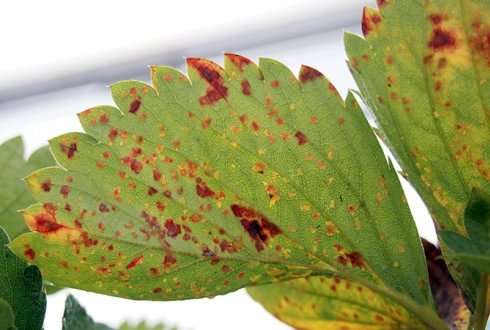How to prevent the Xanthomonas bacterium from spreading

Growers of strawberries and strawberry planting material are terrified of the quarantine organism Xanthomonas fragariae. If the bacterium is found, the affected parcel of land has to be partially or even fully cleared. Commissioned by trade association Plantum and the Strawberry Research Foundation, Wageningen UR performed research into how the pathogen is spread in order to prevent spreading. The applied research method can also be used for other crops.
"Xanthomonas can be very costly for strawberry breeders and farmers", says bacterial diseases expert Jan van der Wolf of Wageningen UR. "Once the bacterium has been found in a plot, it is vital to stop it spreading to other parcels. To do so, one first needs to know exactly how the bacterium spreads; and this is where we come in."
Over recent years it has already been shown that the bacterium could spread among strawberry plants via machinery, especially mowers. Strawberry breeders mow their crops to get rid of excess leaves when the plants are stored in cold storage in winter.
Aerial dispersal
Van der Wolf and his colleagues also studied how the bacterium spreads by air in various conditions. "We used a so-called air sampler, in which air is concentrated in a tube of liquid from where you can culture the collected bacteria."
According to Van der Wolf the research offered some clear insights. "One of the things we studied was the effect of driving rain. It showed that the bacteria spread for several metres at most via large drops, but as soon as the bacteria enter the air via miniscule water particles, they can easily be taken up by the wind. This occurs especially in wet crops that are being mowed."
The research showed that bacteria can end up as far as 100 metres away when mowing wet crops. "At that distance we only found the odd bacterium, but greenhouse tests have taught us that it only requires a few bacteria to infect a plant. This means that there is a real risk of spreading when a healthy crop is situated less than 100 metres from an infected crop."
Measures for mowing

So what can companies do to minimise the risk? Van der Wolf: "The risk of infection of batches that have been multiplied more than once is larger than for batches of a higher class. So start mowing the higher classes before mowing the lower ones. Preferably mow in dry weather and take the wind direction into account. Place a hood over the mower to prevent spreading, and consider eliminating the bacteria on the machine with a disinfectant during or after every mowing session."
Claudia den Braver of Plantum is pleased with these clear results. "It has now been confirmed that strawberry farmers and breeders run great risks when mowing their crops, especially in wet conditions. We will make sure that this new knowledge finds its way to the sector; for example by including the recommendations in the Aardbei Elite quality system, which is used by 95 per cent of the sector in the Netherlands."
Research into the spreading of bacteria
According to Van der Wolf, the Xanthomonas project is an excellent example of research into the spread of plant pathogens via the air. "In principle this research can be performed for any crop; for example potatoes, in which large amounts of bacteria are released when the leaves are being destroyed. Or the harvest of seeds, in which bacteria from mown leaves end up in the air. The results of these types of studies could result in measures to reduce the spread of harmful bacteria."
Provided by Wageningen University




















